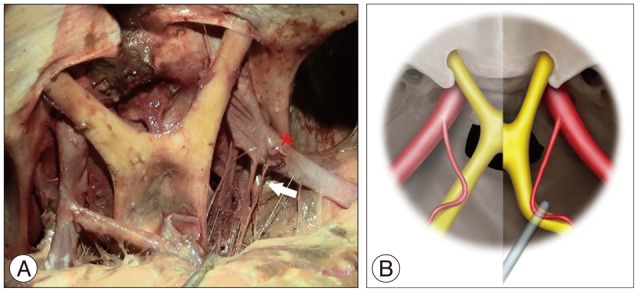J Korean Neurosurg Soc.
2014 Dec;56(6):531-533. 10.3340/jkns.2014.56.6.531.
Demonstration of Traumatic Subarachnoid Hemorrhage from the Anterior Choroidal Artery
- Affiliations
-
- 1Department of Neurosurgery, Jeju National University Hospital, Jeju National University College of Medicine, Jeju, Korea.
- 2Department of Neurosurgery, Soonchunhyang University Hospital Seoul, Soonchunhyang University College of Medicine, Seoul, Korea. drcolor@schmc.ac.kr
- 3Department of Neurosurgery and Neurology, University of Texas Medical School at Houston, Houston, TX, USA.
- 4Department of Neurosurgery, University of Texas Medical School at Houston, Houston, TX, USA.
- KMID: 2191153
- DOI: http://doi.org/10.3340/jkns.2014.56.6.531
Abstract
- We present a case of angiographically confirmed transection of the cisternal segment of the anterior choroidal artery (AChA) associated with a severe head trauma in a 15-year old boy. The initial brain computed tomography scan revealed a diffuse subarachnoid hemorrhage (SAH) and pneumocephalus with multiple skull fractures. Subsequent cerebral angiography clearly demonstrated a complete transection of the AChA at its origin with a massive extravasation of contrast medium as a jet trajectory creating a plume. We speculate that severe blunt traumatic force stretched and tore the left AChA between the internal carotid artery and the optic tract. In a simulation of the patient's brain using a fresh-frozen male cadaver, the AChA is shown to be vulnerable to stretching injury as the ipsilateral optic tract is retracted. We conclude that the arterial injury like an AChA rupture should be considered in the differential diagnosis of severe traumatic SAH.
Keyword
MeSH Terms
Figure
Reference
-
1. Baskaya MK, Coscarella E, Gomez F, Morcos JJ. Surgical and angiographic anatomy of the posterior communicating and anterior choroidal arteries. Neuroanatomy. 2004; 3:38–42.2. Bunai Y, Nagai A, Nakamura I, Ohya I. Traumatic rupture of the basilar artery : report of two cases and review of the literature. Am J Forensic Med Pathol. 2000; 21:343–348. PMID: 11111794.3. Çakmak YÖ, Özdoğmuş Ö, Gürdal E, Uzun İ, Çavdar S. Origins and diameter of the anterior choroidal artery. Marmara Med J. 2009; 22:123–126.4. Filter ER, Fernandes JR. Fatal traumatic subarachnoid hemorrhage due to assault-related tear of the basilar artery. J Forensic Leg Med. 2009; 16:414–416. PMID: 19733334.
Article5. Fung C, Z'Graggen WJ, Beck J, Gralla J, Jakob SM, Schucht P, et al. Trau-matic subarachnoid hemorrhage, basal ganglia hematoma and ischemic stroke caused by a torn lenticulostriate artery. Acta Neurochir (Wien). 2012; 154:59–62. PMID: 21976234.
Article6. Gross A. Traumatic basal subarachnoid hemorrhages : autopsy material analysis. Forensic Sci Int. 1990; 45:53–61. PMID: 2335336.7. Harland WA, Pitts JF, Watson AA. Subarachnoid haemorrhage due to upper cervical trauma. J Clin Pathol. 1983; 36:1335–1341. PMID: 6655067.
Article8. Mosberg WH, Lindenberg R. Traumatic hemorrhage from the anterior choroidal artery. J Neurosurg. 1959; 16:209–221. PMID: 13642112.
Article
- Full Text Links
- Actions
-
Cited
- CITED
-
- Close
- Share
- Similar articles
-
- Oculomotor Nerve Palsy due to Ruptured Multiple Anterior Choroidal Artery Aneurysms
- Transposition of Anterior Choroidal Artery and Posterior Communicating Artery Origin
- Aneurysm at the Origin of the Uncal Artery Arising from the Internal Carotid Artery
- Traumatic Intracranial Aneurysm: A Case Report
- Terson Syndrome after Subarachnoid Hemorrhage Occurred by Thrombolysis and Mechanical Thrombectomy to Treat Acute Ischemic Stroke: A Case Report




